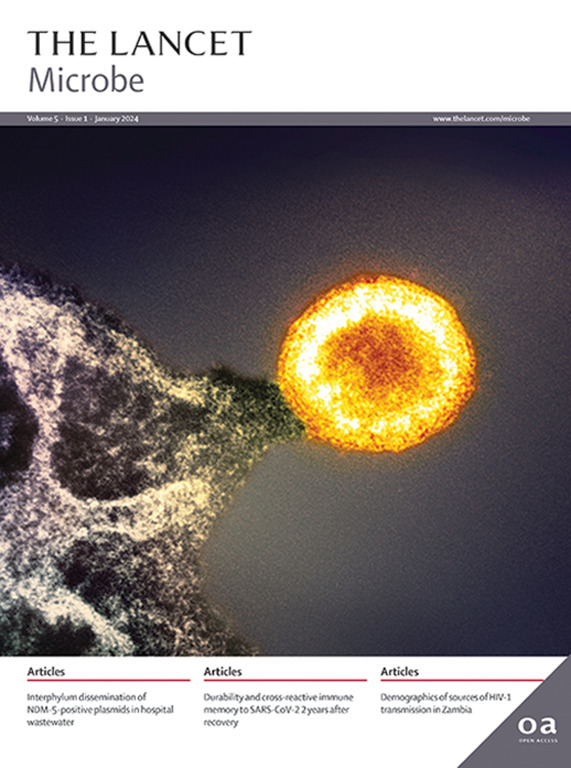Prevalence, misclassification, and clinical consequences of the heteroresistant phenotype in Escherichia coli bloodstream infections in patients in Uppsala, Sweden: a retrospective cohort study
IF 20.9
1区 生物学
Q1 INFECTIOUS DISEASES
引用次数: 0
Abstract
Background
Antibiotic heteroresistance is a common bacterial phenotype characterised by the presence of small resistant subpopulations within a susceptible population. During antibiotic exposure, these resistant subpopulations can be enriched and potentially lead to treatment failure. In this study, we examined the prevalence, misclassification, and clinical effect of heteroresistance in Escherichia coli bloodstream infections for the clinically important antibiotics cefotaxime, gentamicin, and piperacillin–tazobactam.
Methods
We conducted a retrospective cohort analysis of patients (n=255) admitted to in-patient care and treated for E coli bloodstream infections within the Uppsala region in Sweden between Jan 1, 2014, and Dec 31, 2015. Patient inclusion criteria were admission to hospital on suspicion of infection, starting systemic antibiotics at the time of admission, positive blood cultures for the growth of E coli upon admission, and residency in the Uppsala health-care region at the time of admission. Exclusion criteria were growth of an additional pathogen than E coli in blood cultures taken at admission or previous inclusion of the patients in the study for another bloodstream infection. Antibiotic susceptibility of preserved blood culture isolates of E coli was assessed for cefotaxime, gentamicin, and piperacillin–tazobactam by disk diffusion and breakpoint crossing heteroresistance (BCHR) was identified using population analysis profiling. The clinical outcome parameters were obtained from patient records. The primary outcome variable was length of hospital stay due to the E coli bloodstream infection, defined as the time between admission and discharge from inpatient care as noted on the physician’s notes. Secondary outcomes were time to fever resolution, admission to intermediary care unit or intensive care unit during time in hospital, switching or adding another intravenous antibiotic treatment, re-admission to hospital within 30 days of original admission, recurrent E coli infection within 30 days of admission to hospital, and all-cause mortality within 90 days of admission.
Findings
A total of 255 participants with a corresponding E coli isolate (out of 500 screened for eligibility) met the inclusion criteria, with 135 female patients and 120 male patients. One (<1%) of 255 strains was BCHR for cefotaxime, 109 (43%) of 255 strains were BCHR for gentamicin, and 22 (9%) of 255 strains were BCHR for piperacillin–tazobactam. Clinical susceptibility testing misclassified 120 (96%) of 125 heteroresistant bacterial strains as susceptible. The BCHR phenotypes had no correlation to length of hospital stay due to the E coli bloodstream infection. However, patients with piperacillin–tazobactam BCHR strains who received piperacillin–tazobactam had 3·1 times higher odds for admittance to the intermediate care unit (95% CI 1·1–9·6, p=0·041) than the remainder of the cohort, excluding those treated with gentamicin. Similarly, those infected with gentamicin BCHR who received gentamicin showed higher odds for admittance to the intensive care unit (5·6 [1·1–42·0, p=0·043]) and mortality (7·1 [1·2–49·2, p=0·030]) than patients treated with gentamicin who were infected with non-gentamicin BCHR E coli.
Interpretation
In a cohort of patients with E coli bloodstream infections, heteroresistance is common and frequently misidentified in routine clinical testing. Several negative effects on patient outcomes are associated with heteroresistant strains.
Funding
Wallenberg Foundation, Swedish Research Council, and US National Institutes Of Health.
瑞典乌普萨拉患者中大肠杆菌血液感染的患病率、错误分类和异耐药表型的临床后果:一项回顾性队列研究。
背景:抗生素异耐药是一种常见的细菌表型,其特征是在易感人群中存在小的耐药亚群。在抗生素暴露期间,这些耐药亚群可能会增加,并可能导致治疗失败。在这项研究中,我们检查了大肠杆菌血液感染中对临床上重要的抗生素头孢噻肟、庆大霉素和哌拉西林-他唑巴坦的患病率、错误分类和异耐药性的临床效果。方法:我们对2014年1月1日至2015年12月31日期间在瑞典乌普萨拉地区因大肠杆菌血流感染住院治疗的患者(n=255)进行了回顾性队列分析。患者纳入标准为:因怀疑感染而入院,入院时开始使用全身抗生素,入院时大肠杆菌生长血培养阳性,入院时居住在乌普萨拉卫生保健区。排除标准是入院时血液培养物中除大肠杆菌外的其他病原体的生长或先前纳入研究的其他血液感染患者。采用纸片扩散法检测保存血培养的大肠杆菌对头孢噻肟、庆大霉素和哌拉西林-他唑巴坦的药敏,采用群体分析方法鉴定断点交叉异耐药(BCHR)。临床结果参数从患者记录中获得。主要结局变量是大肠杆菌血流感染导致的住院时间,定义为住院和出院之间的时间,并在医生的记录上注明。次要结局为发热消退时间、住院期间入住中间监护病房或重症监护病房、切换或添加另一种静脉抗生素治疗、初次入院30天内再次入院、入院30天内再次发生大肠杆菌感染、入院90天内全因死亡率。结果:共有255名具有相应大肠杆菌分离物的参与者(500名筛选合格者)符合纳入标准,其中135名女性患者和120名男性患者。一(解释:在大肠杆菌血流感染患者队列中,异源耐药是常见的,并且在常规临床检测中经常被误诊。对患者预后的一些负面影响与异耐药菌株有关。资助:瓦伦堡基金会、瑞典研究委员会和美国国立卫生研究院。
本文章由计算机程序翻译,如有差异,请以英文原文为准。
求助全文
约1分钟内获得全文
求助全文
来源期刊

Lancet Microbe
Multiple-
CiteScore
27.20
自引率
0.80%
发文量
278
审稿时长
6 weeks
期刊介绍:
The Lancet Microbe is a gold open access journal committed to publishing content relevant to clinical microbiologists worldwide, with a focus on studies that advance clinical understanding, challenge the status quo, and advocate change in health policy.
 求助内容:
求助内容: 应助结果提醒方式:
应助结果提醒方式:


